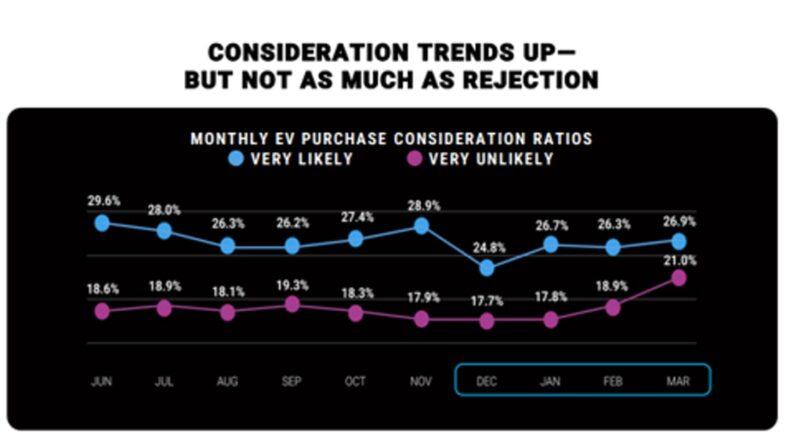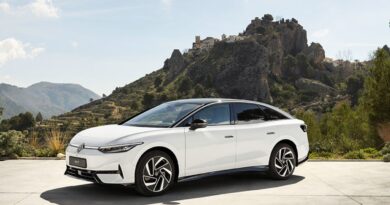Charging issues, pricing prompt more shoppers to avoid EVs
Despite electric vehicle tax credits and significant efforts to expand public charging, the share of new-vehicle shoppers who will avoid EVs has grown over the past three months, according to J.D. Power.
In March, 21 percent of new-vehicle shoppers surveyed said they are very unlikely to consider an EV, up from 19 percent in February and 18 percent in January. The percentage of shoppers who said they are very likely to consider an EV has remained relatively flat over the past three months, landing at 27 percent in March. About 34 percent of shoppers said they are somewhat likely to consider an EV, and 18 percent said they are somewhat unlikely.
Resistance to an EV reflects concerns about lack of public charging infrastructure and high prices, J.D. Power said in its March E-Vision Intelligence Report, based on responses from about 2,000 new-vehicle shoppers.
To a lesser extent, EV reluctance could be driven by macroeconomic headwinds, such as rising interest rates, recession fears and stable gasoline prices, said Stewart Stropp, J.D. Power’s executive director of EV intelligence.
EVs made up 7.3 percent of U.S. market share in March, according to the firm, down from 8.5 percent in February but up from 5.5 percent in March 2022, J.D. Power said.
Recent announcements to expand the public charging network by Walmart, Tesla and others haven’t swayed resisters, J.D. Power found.
That’s largely because consumers haven’t seen those chargers yet, said Sam Fiorani, vice president of global forecasting at AutoForecast Solutions.
“The promise of future growth does not help to instill your confidence today,” he said.
Poor charger reliability also creates EV reluctance. J.D. Power found that 1 in 5 public charging attempts failed last year.
“Hopefully we’ll start to see the tide turn on that as we do get more infrastructure build-out going with things like bipartisan infrastructure law support,” Stropp said. “But right now [infrastructure] is a key worry bead.”
Shoppers who own an EV — 3 percent of J.D. Power’s respondents — are very likely to purchase an EV again, Stropp said. Over the past six months, 71 percent of current EV owners said they were very likely to purchase another.
Automakers will have more than 50 EV nameplates on sale in the U.S. in a range of prices and styles by the end of this year. Still, new-vehicle shoppers continue to worry about pricing, even though EVs are getting closer to price parity with comparable gasoline models.
About half of new-car buyers in the U.S. could find an EV at the price and size they want and from their favored brand by the end of this year, J.D. Power said in its February E -Vision report.
The EV consideration data reflects consumer perception, Stropp said. Some EVs are already more affordable than comparable gasoline models, especially with the EV tax credit.
“A lot of people are still looking at just the MSRP and perceiving EVs as being more expensive than the ICE vehicle alternatives across the board,” he said.
Evolving tax credit qualifications have confused consumers and dealerships.
Under the Inflation Reduction Act, buyers who meet certain income thresholds can get a tax credit of up to $7,500 for North American-assembled new EVs that also meet sticker price restrictions.
Starting April 18, the credit was split, with $3,750 for EVs that have at least 40 percent of the value of the battery’s critical minerals extracted or processed in the U.S. or in a country where the U.S. has a free-trade agreement, or from materials that were recycled in North America. Another $3,750 is available if at least half of the value of the EV’s battery components is made or assembled in North America.
The percentage requirements increase over time, maxing out at 80 percent in 2027 for minerals and 100 percent in 2029 for battery components.
Consumers are trying to determine which vehicles qualify for the tax credits and how much they are eligible for.
“It’s going to take some time for the industry and the shopper population to really figure it out to a point where it starts to have a bigger impact on decision making,” Stropp said.
The credits have also created chaos at dealerships, Robert Simmons, executive general manager, at LaFontaine Automotive Group, said during an Automotive News LinkedIn Live event Wednesday.
“It changes every day and we’re getting more and more information on it,” Simmons said. “It’s not an easy job right now.”
For now, the perplexity around EV tax credits, designed to make the vehicles an easier purchase decision, could make consumers walk away, said Conrad Layson, senior alternative propulsion analyst at AutoForecast Solutions.
“If something is too confusing,” he said, “the tendency is not to get involved.”
Audrey LaForest contributed to this report.
Source : Autonews.com




